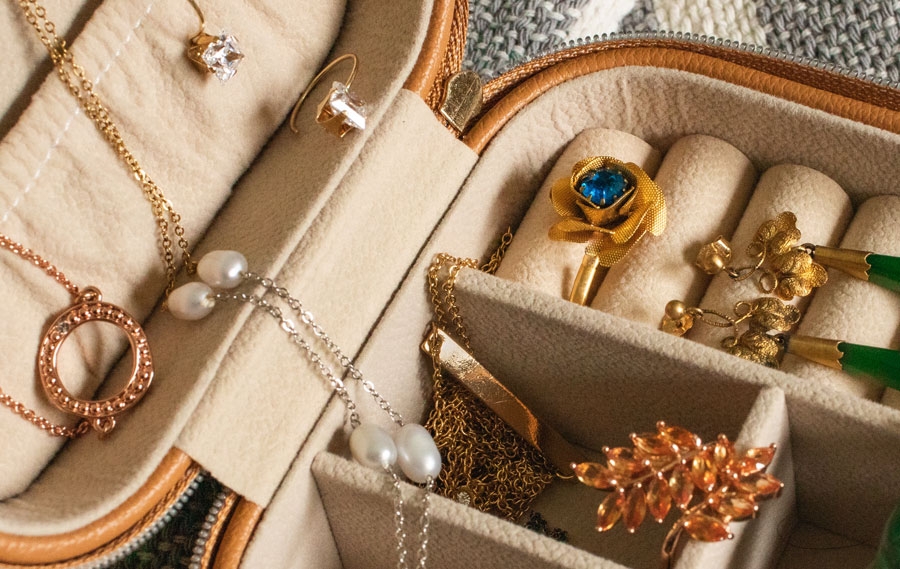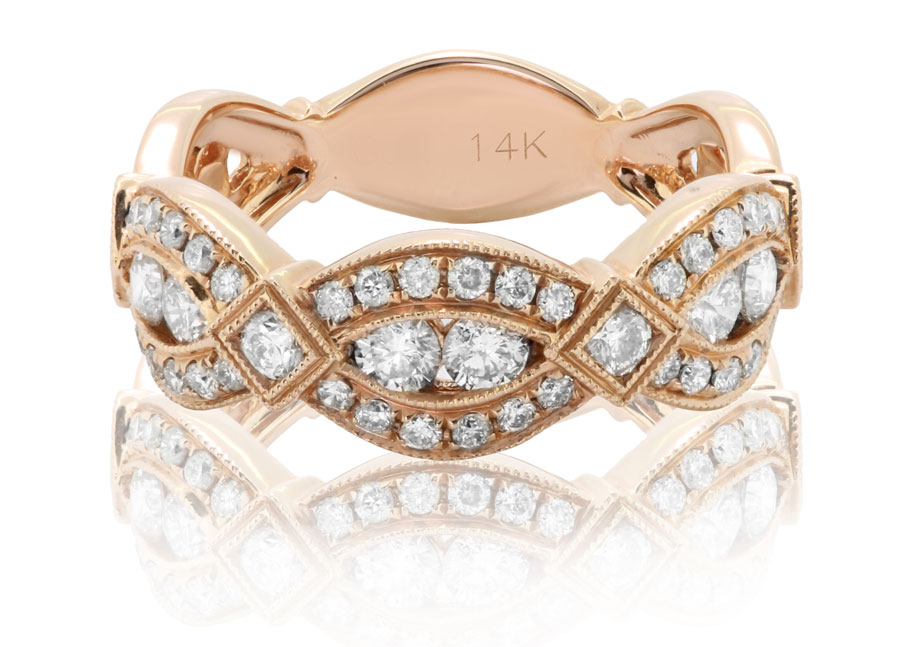Precious Metals 101: Gold

You’re sitting at a table with a jewelry box that belonged to your grandmother. You open the lid and see all sorts of vintage treasures: tie pins, brooches, sparkly earrings, pocket watches, coins, and a charm bracelet with tiny dangling pendants and baubles. While it all has sentimental value, you can’t help but wonder, “What is this worth?”
That’s where a good understanding of precious metals comes in—and we’re here to deliver with a series devoted to these scarce, sought-after materials. Whether you’re assessing your own collection or hunting for treasure out in the wild, knowing the difference between precious and non-precious metals will come in handy.
The elite Precious Metal Club is made up of three naturally occurring elements: gold, silver, and platinum. Let’s start with good ol’ glamorous gold.
How to Identify Gold
As you know, gold is very valuable and highly sought after. Why? It’s rare, malleable, and durable. Its malleability makes it an excellent material for coins, jewelry, decorative items, and intricate detailing. Since it doesn’t rust, oxidize, or corrode, those items can have quite a lifespan. It doesn’t hurt that gold has been closely intertwined with currency for thousands of years.
The Look
Naturally yellow in color, the appearance of gold can be altered with the addition of secondary materials. For example, adding zinc or nickel leads to white gold, while adding copper creates the warm hue of rose gold. Additive alloys are used to create a spectrum of colors, from pink to green. Because of this, it’s important to take more than appearance into account when inspecting a suspected gold piece.
Other precious metals include silver, platinum, palladium, and rhodium. These metals have similar properties to gold, such as high density, luster, and resistance to corrosion. However, they all have different colors and melting points.
The Purity
When assessing fine jewelry, it’s essential to understand the gold purity system. The purity of gold is measured in karats (k or kt), which indicate how many parts of gold are in 24 parts of the metal. For example, 24k gold is pure gold, while 14k gold has 14 parts of gold and 10 parts of other metals. Simply put, the higher the purity, the higher the value. Now, how does the average buyer determine this? Luckily, modern gold is often stamped with a hallmark denoting its purity. Take a look at the table below:
| Purity Hallmark | Gold Content (wt. %) | Purity % Hallmark |
|---|---|---|
| 24k | 99+ | 990 |
| 22k | 91.6 | 916 |
| 18k | 75.0 | 750 |
| 14k | 58.5 | 585 |
| 9k | 37.5 | 375 |
Keep in mind that not all gold is marked. Antique, custom, and altered pieces may lack identifying marks. That’s why Blue Moon Estate Sales pros are trained to identify and test precious metals to determine their purity and price them appropriately.

You may notice a few other hallmarks as you’re inspecting pieces, specifically when it comes to estate jewelry. It’s common for makers to include a maker’s mark which can be especially exciting to identify. Other marks you may find may indicate that a piece is not solid gold, thus affecting its overall value. Such marks include:
| Marking | Meaning |
|---|---|
| GF | Gold fill: A base metal with a bonded alloy layer of 10k or more |
| GP | Gold plate: A base metal with a thin layer of gold chemically plated to the surface |
| GEP | Gold electroplate: A base metal with a thin layer of gold electrochemically plated to the surface |
| RG | Rolled gold: A base metal rolled in a thin coating of gold |
| RGP | Rolled gold electroplate |
| HGE | Heavy gold electroplate |
| 925, STERLING or any other silver mark on a gold surface | Vermeil: Silver coated in a thick gold alloy layer of 14k or more |
FAQs
Check out these frequently asked questions about shopping for gold jewelry at estate sales!
Finding Gold Jewelry & Collectibles at Estate Sales
Estate sales are great places to find gorgeous vintage jewelry and other pre-owned collectibles for a fair price. Here's how to find gold jewelry and collectibles at estate sales:
- Do your research before attending an estate sale. Look for online listings or ads that mention what kinds of items will be sold at the estate sale. Look for keywords such as "gold", "jewelry", "coins", "collectibles", etc.
- Arrive early to get the best selection and deals. Estate sales usually start early in the morning and last for a few hours or days. The earlier you arrive, the more chances you have to find what you are looking for.
- Bring cash. Some estate sales only accept cash as payment, so make sure you have enough cash on hand to buy what you want.
- Bring tools to test the items such as a magnifying glass and a magnet. Before buying estate jewelry, inspect and test the items for authenticity and purity.
- Negotiate with the sellers if possible. Estate sales are often run by professional companies or family members who want to sell the items quickly and clear out the space. You may be able to negotiate the price down if you buy multiple items, offer cash, or discover flaws or damages in the items.
Shop for Antique Jewelry with Help from Blue Moon Estate Sales
Gold is one of the most sought-after and valuable metals in the world. It has been used for jewelry, coins, art, and technology for thousands of years. Now that you’re equipped with some valuable knowledge about how to identify precious metals and how to go about buying gold during the estate sale process, you may want to take a look through your own collection. If you have any gold coins or jewelry you're looking to rehome, don't just pawn them off. Give us a shout. We can discuss your best options, including consignment.
We take our estate sale treasures seriously, especially when it comes to precious metals. We love nothing more than the thrill of the hunt, so if you're looking to strike gold without spending a fortune, head out to a Blue Moon sale near you. We'll see you there!
